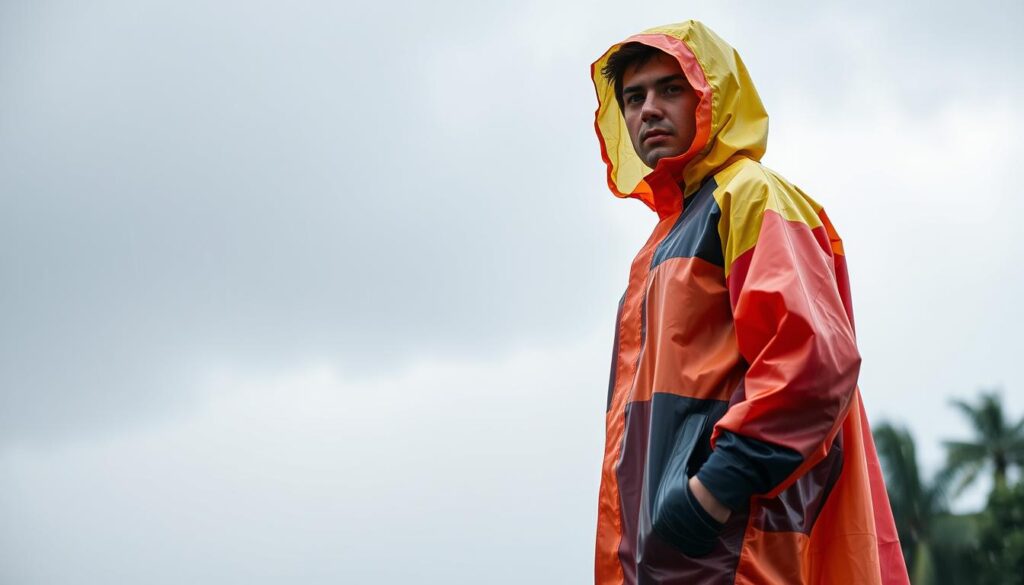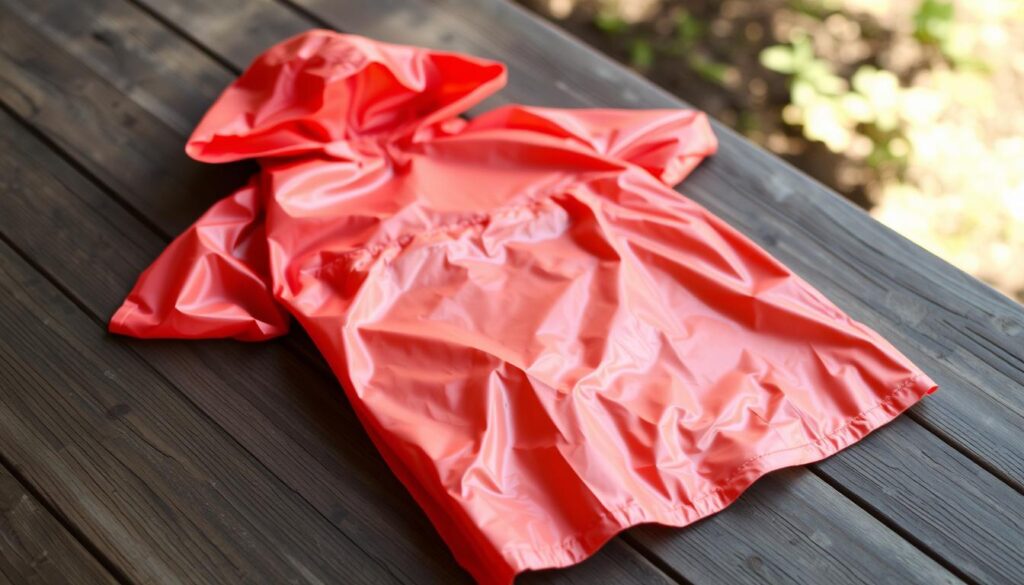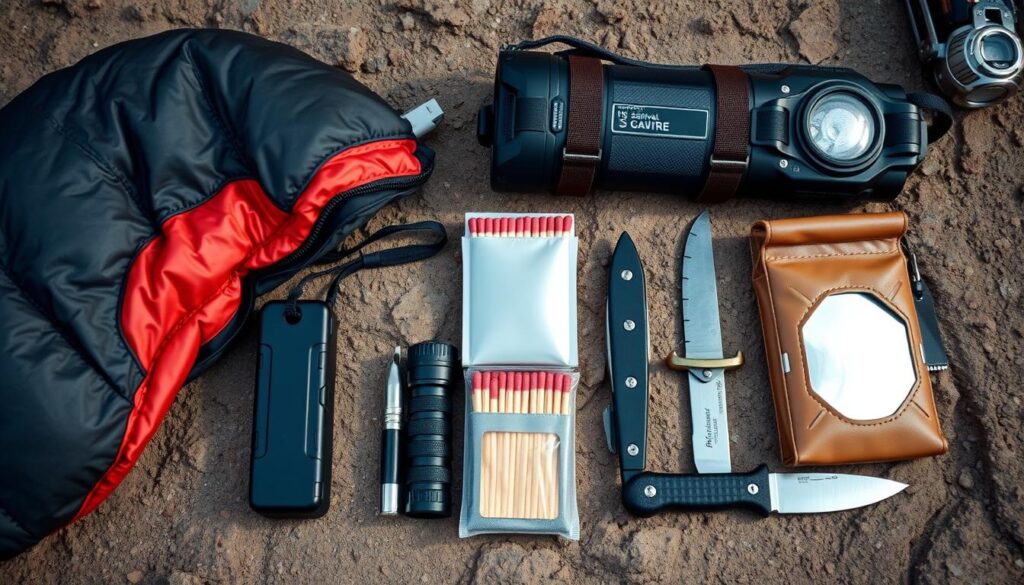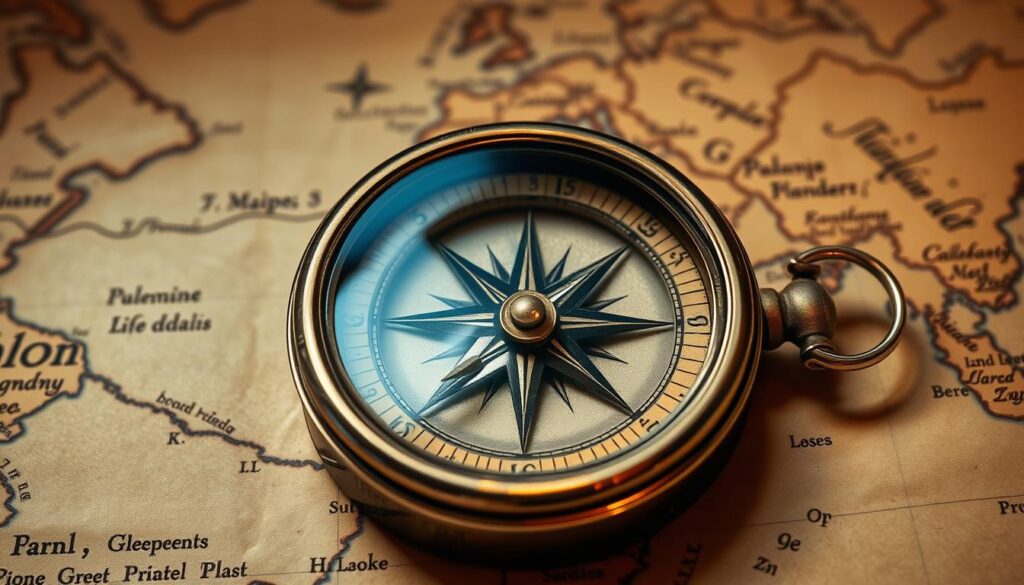I love spending time outdoors, but bad weather can be a real challenge. Being caught in the rain without the right gear is scary. That’s why an emergency poncho is so important. It keeps you dry and comfy until you find a place to hide.
Making an emergency poncho is easy. You can use a heavy-duty trash bag, an old shower curtain, or buy vinyl. The material should be 50-60 inches wide and 60-70 inches long. Make sure there’s a hole for your head.
Having an emergency poncho is a big help when it rains suddenly or when you’re in the woods. It shows how important it is to be ready. In this DIY guide, I’ll show you how to make your own emergency poncho. This way, you’ll be ready for anything the weather throws your way.
Key Takeaways
- An emergency poncho is a must-have for outdoor lovers.
- You can make one using things like a heavy-duty trash bag or an old shower curtain.
- The best size for an emergency poncho is 50-60 inches wide and 60-70 inches long.
- An emergency poncho can save your life in bad weather.
- This DIY guide will teach you how to make your own emergency poncho.
Understanding the Importance of an Emergency Poncho
An emergency poncho is more than just a piece of gear; it’s a key survival tool for unexpected weather. When outdoors, whether hiking, camping, or doing other activities, the weather can change fast. A reliable emergency poncho can greatly improve your safety and comfort.
Outdoor lovers face many challenges, like sudden rain or cold drops. An emergency poncho acts as a versatile tool to shield you from the elements. Its value is huge, mainly for those who spend a lot of time in the wild or on outdoor adventures.
Why Every Outdoor Enthuisast Needs One
Every outdoor enthusiast should carry an emergency poncho. It’s not just a safety measure but a must-have that can be very useful in emergencies. The poncho can be used as a raincoat, a shelter, or even as a signal in emergencies. Its many uses make it a key item for outdoor explorers.
Key Benefits of an Emergency Poncho:
- Provides protection against rain and wind
- Can be used as a shelter or ground tarp
- Serves as a signaling device in emergency situations
- Compact and lightweight, making it easy to carry
Common Situations Where a Poncho Comes in Handy
An emergency poncho is very useful in many situations. For example, during hikes or camping, it keeps you dry and warm from unexpected rain or wind. It can also act as a makeshift shelter if you get lost or stranded.
| Situation | How a Poncho Helps |
|---|---|
| Unexpected Rain | Keeps you dry and comfortable |
| Lost or Stranded | Serves as a shelter or signaling device |
| Cold Weather | Provides an extra layer of warmth |
In conclusion, an emergency poncho is a vital piece of gear for outdoor enthusiasts. Its versatility, small size, and ability to save lives in emergencies make it essential for any outdoor adventure.
Materials Required to Make an Emergency Poncho
To make a good emergency poncho, you need the right stuff. The secret to success is picking materials that last and work well.
For the main part, you have a few good choices. You can pick a waterproof and reusable poncho material like rip-stop nylon. It’s tough and doesn’t tear easily. Or, you can use a heavy-duty trash bag. It’s a lightweight emergency poncho that’s easy to carry in your backpack.
Choosing the Right Material
The material should be waterproof and handle different weather. Rip-stop nylon is a top pick because it’s waterproof, light, and folds up small. It’s perfect for a compact poncho.
But, a big, thick trash bag can also be a poncho in a pinch. It’s not as strong as rip-stop nylon, but it’s easy to find and works for now.

Additional Supplies You'll Need
Along with the main material, you’ll need some extra things. These are:
- Scissors or a sharp knife to cut the material to size.
- Duct tape or strong adhesive tape to hold the edges and make holes for your head and arms.
- Optional: reflective tape or material to make you more visible when it’s dark.
With the right materials and extras, you can make a dependable emergency poncho. It will keep you dry when the weather surprises you.
Step-by-Step Instructions for DIY Emergency Poncho
Making a DIY emergency poncho is easy and keeps you dry in rain or wet weather. It only takes a few steps with basic materials. This makes it a great project for anyone.
Measuring and Cutting the Fabric
First, measure and cut a piece of fabric or plastic to the right size. A large trash bag or a 40×60 inch fabric works well for a standard poncho. If using a trash bag, follow this guide on making a trash bag. For other materials, mark the size with a tape or ruler and cut it with scissors or a craft knife.
Creating Openings for Head and Arms
After cutting your fabric, make openings for your head and arms. For trash bag ponchos, cut the bottom edge for the head and make slits for the arms. The head hole should be in the middle, and arm slits about 4-6 inches apart.
Securing the Edges to Prevent Fraying
Next, secure the edges to stop fraying. For plastic or vinyl, like trash bags, this isn’t as important. But for fabric ponchos, fold the edges over twice and sew or staple them. You can also use fabric glue or fray check to prevent fraying.
Personalizing Your Emergency Poncho
Being outdoors a lot, I think making your emergency poncho personal is key. It’s not just for staying dry; it’s about being seen and safe. I focus on adding reflective material and picking a color that suits you.
Adding Reflective Material for Visibility
Being visible is a big deal when you’re in the wild or in the rain. Adding reflective stuff to your poncho helps a lot. Use reflective tape or fabric to make it easier for others to see you, even when it’s dark.
Putting reflective strips on the hood or seams is a smart move. It’s a simple way to stay safe.

Choosing a Color That Works for You
The color of your poncho matters a lot. Bright colors like orange or yellow are good for being seen. But, it’s also about what you like or where you’ll be.
In snowy places, bright colors pop out. But in dense forests, a color that blends in might be better. It’s about being ready for anything.
Personalizing your emergency poncho makes it more useful and feels like it’s yours. Adding reflective bits and picking the right color means you’re ready for anything. It’s a smart move for anyone who loves the outdoors or just wants to be prepared.
Tips for Storing Your Emergency Poncho
Storing your emergency poncho right means it’s ready when you need it. A well-stored poncho is key for emergency preparedness. It helps you tackle outdoor challenges effectively.
Best Practices for Folding and Storing
Folding your lightweight emergency poncho right is key for easy storage. Here’s how to do it:
- Fold the poncho in half along its centerline.
- Roll it tightly from the bottom hem towards the hood.
- Secure the roll with the poncho’s ties or a small strap.
This folding method makes the poncho smaller. It’s easier to fit in a backpack or emergency kit. Plus, it keeps your compact poncho safe from damage.
Ideal Locations for Easy Access
It’s important to store your emergency poncho where you can get to it fast. Here are some good spots:
| Location | Advantages |
|---|---|
| Backpack or Hiking Bag | Always with you during outdoor activities |
| Emergency Kit or First Aid Box | Easily accessible in case of an emergency |
| Car or Vehicle Storage | Ready for use during car emergencies or stops |
By keeping your poncho in one of these spots, you’re ready for any weather or emergency.
How to Test Your Emergency Poncho
Before using my emergency poncho, I need to check if it’s water-resistant and durable. Testing is key to make sure it works well in bad weather.
Steps to Ensure Water Resistance
To test my emergency poncho’s water resistance, I’ll follow these steps:
- Look for any tears or weak spots in the material.
- Apply a water-repellent treatment if it’s not waterproof.
- Do a water soak test by soaking a small part of the poncho in water.

After soaking, I’ll see if water gets through. If not, I’ll test it under running water with a hose or watering can.
Practical Durability Tests
To check my emergency poncho’s durability, I’ll do these tests:
| Test | Description | Expected Outcome |
|---|---|---|
| Tensile Strength Test | Gently pull on the fabric to check its strength. | The fabric should resist tearing. |
| Abrasion Resistance Test | Rub the fabric against a rough surface. | The fabric should show minimal wear. |
| Seam Integrity Test | Inspect the seams for any signs of weakness. | The seams should be secure and not come apart easily. |
By doing these tests, I’m sure my emergency poncho is both waterproof and durable. It will give me reliable weather protection when I need it.
Maintenance for Longevity of Your Poncho
To keep your emergency poncho working well, regular care is key. A well-kept poncho can save your life. Here’s how to keep it in top shape.
Cleaning Guidelines for Different Materials
Each material needs its own cleaning method. For example, a rip-stop nylon poncho can be cleaned with mild detergent and cold water. Always check the maker’s instructions to protect the waterproof layer and fabric.
For silicone-coated nylon, use gentle soap and lukewarm water. Stay away from harsh chemicals or rough cleaners that can harm the waterproof layer or damage the fabric.
Repairing Minor Wear and Tear
Small damages like tears or loose threads can be fixed with a needle and thread or a special outdoor gear repair kit. Fix these problems quickly to stop them from getting worse.
| Material | Cleaning Method | Repair Method |
|---|---|---|
| Rip-stop Nylon | Mild detergent, cold water | Needle and thread, repair kit |
| Silicone-coated Nylon | Gentle soap, lukewarm water | Seam sealer, repair tape |
By following these tips, you can make your emergency poncho last longer. It will stay a trusted part of your emergency gear for outdoor adventures.
Incorporating Your Poncho into an Emergency Kit
An emergency kit is not complete without a reliable poncho. I’m here to guide you on how to incorporate yours effectively. When it comes to emergency preparedness, having the right items in your kit can make all the difference.
My DIY emergency poncho is designed to be a key element in your emergency kit. It provides protection from the elements when you need it most. To maximize its effectiveness, it’s essential to pair it with other vital items.
Essential Items to Pair with Your Poncho
To create a complete emergency kit, consider including the following essential items alongside your poncho:
- A first-aid kit to treat minor injuries
- A flashlight and extra batteries to provide light during nighttime or in dark environments
- A multi-tool or pocket knife for various tasks
- A warm blanket or emergency bivvy sack to stay warm
- A means of communication, such as a cell phone with a charger and a backup power source
These items, when combined with your emergency poncho, will significantly enhance your overall emergency preparedness.
Upgrading Your Emergency Kit Regularly
It’s not enough to simply assemble an emergency kit; you must also regularly inspect and update it. Check your kit at least twice a year to:
- Verify that all items are usable and not expired
- Update any items that have been used or have expired
- Ensure that your kit meets your current needs, considering any changes in your environment or activities
By incorporating your emergency poncho into a well-maintained emergency kit, you’ll be better prepared to face unexpected situations with confidence.
Real-Life Uses for My Emergency Poncho
I’ve tested my emergency poncho in many real-life situations. It’s been a game-changer for my outdoor adventures. The outdoor poncho keeps me dry in unexpected rain showers. It’s also a versatile piece of gear for hiking and camping trips.
Experiences from Hiking and Camping
On a memorable hiking trip, I got caught in a sudden downpour. My emergency poncho saved the day, keeping me dry and comfy. On another camping trip, it added extra weather protection. This ensured a good night’s sleep.
Feedback from Family and Friends
Family and friends who’ve seen or used my emergency poncho love it. They appreciate its compactness and the peace of mind it gives. One friend, an avid camper, bought a similar poncho. He said mine is a great example of a reliable outdoor accessory.
Conclusion and Final Thoughts on My DIY Emergency Poncho
Making a DIY emergency poncho is a simple way to get ready for emergencies. This guide has helped you take a big step towards staying safe in bad weather.
As shown, making an emergency poncho is easy and needs just a few things. It’s important to be ready and have a poncho in your emergency kit. This guide has shown you how to pick the right materials and test your poncho.
Emphasizing Preparedness and Safety
Being ready for emergencies means being proactive and simple steps to stay safe. Having an emergency poncho helps you deal with unexpected situations. I suggest checking your emergency kit often and updating it when needed.
Encouraging Others to Get Creative
When thinking about emergency preparedness, be creative with your kit items. A DIY emergency poncho is a great example of taking control of your safety. By making your own poncho, you’re not only ready but also empowered to face the unexpected.
FAQ
What is an emergency poncho, and why is it necessary for outdoor enthusiasts?
An emergency poncho is a lightweight, waterproof garment. It keeps you dry in rain or wet conditions. It’s vital for outdoor lovers, as it can save lives in hiking, camping, or survival situations.
What materials are best suited for making an emergency poncho?
Use waterproof and durable materials like rip-stop nylon or heavy-duty trash bags. These materials resist water well and can handle harsh weather.
How do I personalize my emergency poncho for better visibility?
Add reflective material to make your poncho more visible in the dark. You can attach reflective strips or tape to it.
How should I store my emergency poncho to ensure it’s easily accessible?
Fold and store your poncho compactly. Keep it in your backpack or emergency kit for easy access.
How can I test my emergency poncho for water resistance and durability?
Test your poncho by spraying it with water or exposing it to rain. Check for leaks and test its material’s water resistance. Also, check its durability.
What are the essential items to pair with my emergency poncho in an emergency kit?
Pair your poncho with a first-aid kit, flashlight, extra batteries, and basic survival tools. Update your kit regularly to stay prepared.
Can I reuse my emergency poncho if it gets wet or dirty?
Yes, you can reuse a durable poncho. But clean and dry it well to keep it lasting longer. Follow the cleaning guide for your poncho’s material.
How often should I inspect and maintain my emergency poncho?
Check your poncho often for wear and tear. Clean and repair it as needed. This keeps it in good shape for when you need it.



